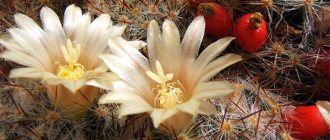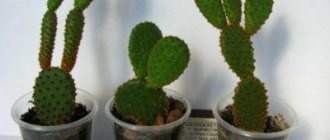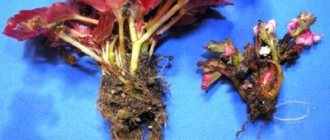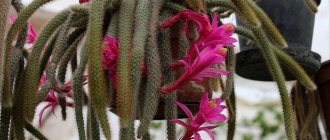Growing rebutia from seeds
https://youtube.com/watch?v=emGhaDhzUjU
In nature, rebutia reproduces excellently by self-seeding: the fruit cracks, the seeds fall to the ground and germinate, and soon small cacti appear not far from the mother plant. Flower growers use this method extremely rarely, because the seeds are small and not very convenient for sowing; they also need to be purchased at a flower shop.
The procedure includes the following steps:
- Fill wide containers with an earth mixture prepared on the basis of 2 parts turf soil with the addition of 1 part sand and the same amount of peat;
- Level the soil surface and spray with a fine spray;
- Mix the seeds with fine sand for ease of sowing and distribute over the soil, as if pouring salt into a dish;
- Provide diffuse lighting and an air temperature of at least 22 °C;
- The seedlings will be very dense, thin them out using tweezers;
- When the seedlings grow to a height of 2 cm, they can be planted in separate containers.
Possible problems
The cactus does not grow - lack of moisture in summer, watering in winter, lack of nutrients. Elongated, deformed stem - poor lighting in summer, warm wintering. Cork spots on the stem - hypothermia, lack of water in summer, pest damage.
As you can see, rebutia is an amazing cactus, which itself is overgrown with a whole family of “hedgehogs”, blooms beautifully and is not too demanding to care for. Give the rebutia a little warmth - and it will decorate your windowsill for many years.
And for the most curious, we suggest you watch the video about rebuttion https://www.youtube.com/watch?v=2ZqU4wxGdUw
Types of rebutia description and photo
Varieties and types of phlox description, photo
In nature, there are up to 19 types of rebutia.
The following plant species are grown in indoor floriculture:
Rebutia is tiny - the plant has a spherical stem up to 5 cm in diameter with a flattened top. The papillae are arranged in a spiral pattern on the stem. The flowers are red. It grows naturally in Argentina;
Rebutia Marsonera - stalk dimensions are 5 cm in diameter and 4 cm in height. This type of rebutia has yellow flowers. It grows in northern Argentina;
Rebutia senile - it has a relatively large stem (8 cm in height and 7 cm in diameter). The flowers are large (up to 3.5 cm in diameter), red. The plant is native to Argentina.
Considering the types of rebutias in the description with photos, you can choose the appropriate varieties for your indoor window sill:
In addition, there are such types of rebuttal as:
Rebutia marsonerii Werd. It is distinguished by rusty-brown bristle-like spines and large canary-yellow flowers.
Rebutia kariusiana Wessn. is a recently discovered rare species with a pink corolla of magnificent flowers.
Rebutia violaciflora Bckbg. belongs to the most famous species. The plant has thin brown-yellow spines and glowing pink-purple flowers.
Rebutia senilis Bckbg. has the densest and shortest glassy white bristles. The flowers are red. Numerous varieties of this species have all kinds of thorns and flowers from yellow and orange to pink.
Rebutia minuscula K. Sch. has a pale green stem up to 5 cm in diameter and early, fiery red flowers.
Rebutia Aylostere albiflora. Globular cacti forming small groups. The diameter of the stems is 1.8-2.5 cm. There are 14-16 ribs, they are with tubercles. There are about 5 central spines, up to 15 radial spines.
Rebutia schatzliana. Spherical solitary cacti. The diameter of the stems is up to 1.5 cm. There are 16 ribs, they are with tubercles. There are 0-2 central spines, up to 13 radial spines.
Rebutia Weingartia arenacea. The diameter of the yellow-green stems is 2.5-5.0 cm, their height is 2.0-3.5 cm. There are about 30 ribs, they have distinct tubercles. Spines 14-16.
Rebutia brunescens. Single spherical cacti with reddish-violet stems. Their diameter is 5 cm. There are 13-14 ribs, they have rounded tubercles. Central spines 0-2, radial spines 11-13.
Rebutia cardenasiana. Spherical single cacti up to 5 cm high and up to 8 cm in diameter. There are 14-16 ribs, they are arranged in a spiral, with tubercles. Synonyms: Sulcorebutia cardenasiana. Weingartia cardenasiana.
Rebutia Weingartia cylindrica. Cacti form small groups. The height of the stems is up to 12 cm, diameter - 4-5 cm. There are about 16 ribs. There are up to 4 central spines, 10-12 radial spines.
Rebutia fabrisi. Cacti form small groups. The height and diameter of the stems is up to 2 cm. The ribs are arranged in a spiral, with tubercles. The spines are numerous, 4-8 mm long. The length of the red flowers is 2.5 cm.
Aylostera fulviseta. The height of the dark green stems is 1.5 cm, the diameter is 1.0 cm. There are up to 16 ribs, they are with tubercles. There are 1-3 central spines, their length is up to 1 cm; radial spines - 10-12.
Rebutia gonjianii. The height of the dark green stems is up to 2 cm, diameter -2.5 cm. There are up to 38 ribs, they have tubercles arranged in a spiral. The spines are only radial, there are 24-26 of them.
Rebutia huasiensis. Single spherical cacti with purple stems. Their height is 7 cm, diameter is 3.5 cm. There are 13-14 ribs, they have wild-shaped tubercles. Central spines 0-1, radial spines 7-8.
Rebutia narvaecensis. Cacti form small groups. The height of the gray-green spherical stems is 3.0-3.5 cm, the diameter is 2.5-3.5 cm. There are about 18 ribs. The areoles are round and white. Needles 10-20.
Rebutia perplexa. The height of the light green stems is 1.2-2.0 cm, the diameter is 1.2-1.5 cm. There are 16-18 ribs, they are arranged in a spiral. The areolas are round and white. There are 10-16 needles, they are golden, only 1-2 mm long.
Rebutia ritteri. The height of the stems is 5 cm, the diameter of the stems is 3.5 cm.
Rebutia pulvinosa. Cacti form small groups. The diameter of the stems is 3 cm. Ribs with tubercles. Areolas are round. There are up to 6 central spines, 15-22 radial spines.
Rebutia spegazzmiana. The diameter of single stems is 2.5 cm. There are 13 ribs, they are with tubercles and arranged in a spiral. There are 1-4 central spines, they are up to 7 mm long. radial spines 11-13.
Rebutia spinosissima. Cacti form dense “cushions.” The height and diameter of the stems are 4 cm. There are about 15 ribs. There are 5-6 central spines, there are many radial spines.
Rebutia steinmannii. The height of the stems is up to 7 cm, diameter - 8 cm.
Popular varieties of Rebutia cactus with photos
As mentioned above, the genus Rebutia is represented by about 40 species and many artificially bred varieties. We will describe several varieties that appeal to many cactus lovers.
Rebutia fiebrigii
Small cactus. At the beginning, a single stem grows, later it reproduces many children, forming a small “mound”. Stems are spherical to slightly cylindrical, 6 cm in diameter.
There are short white spines and light green tubercles. Yellow or bright red flowers grow from the middle of the stem and measure 4 cm in diameter and height.
Rebutia krainziana
A cactus that produces dark green barrel-shaped stems up to 7 cm in diameter with contrasting small white areoles and spines. Large, bright red flowers with yellow necks appear in late spring.
Over time, children will develop around the main stem, forming a dense clump. Cacti look impressive during flowering (some color variations are possible).
Tiny Rebutia (Rebutia minuscula)
The homeland of this mountain species is in northern Argentina. The stems are lumpy, pale green, flattened, 6 cm in diameter and 3.5 cm in height. Noticeable tubercles are formed in rows 16-20.
The stem is covered with whitish very small radial needles. The red to orange flowers can reach 5 cm in diameter. They grow at the base of the stems and last for several days.
Rebutia marsoneri
A small, abundantly flowering cactus with spherical stems. The stems are up to 8 cm in diameter. The spines are short, thin, brown to yellow or white with darkish tips.
From the base of the stem grows a variety of flowers ranging from golden to reddish in color and up to 5 cm long. This is one of the early flowering species of Rebutia.
Rebutia deminuta
Argentine cactus grows in groups with spherical or short cylindrical stems. The stem reaches a diameter of up to 6 centimeters with fibrous roots. Ribs 11 to 13 are arranged in a spiral.
The areoles are whitish-gray. 10 to 12 (or more) central curved spines grow. They are white-brown, 3 to 6 mm long (rarely 20 mm) with a brown tip. The flowers are dark orange-red in color, up to 3 centimeters in length and the same diameter.
Rebutia fulviseta
The cactus grows individually or in groups. The stem is spherical or short cylindrical, dark green. The stem is 7 cm wide and up to 15 cm high, forms up to 16 ribs arranged in a spiral and clearly divided into tubercles. The areolas on it are brown. The spines are yellowish-brown to reddish.
Dark red flowers up to 2.5 centimeters in length and the same diameter. The spherical fruits are dark red in color and have a diameter of up to 5 mm.
Heliosis or solar rebutia (Rebutia heliosa)
A small, slow-growing cactus with a spherical or cylindrical stem. This species is native to the mountainous regions of Bolivia. The stem dimensions are up to 5 cm high and 2.5 cm wide. Short spines are up to 1 mm long.
In summer, funnel-shaped reddish or orange flowers appear from the old halo; flowering lasts up to 10 days.
You can also see in this video different types of Rebutia
The article uses materials from the site care-plants.com
Reproduction of rebutia, growing cactus from seeds
Charming corydalis description, types and photo of the flower
The succulent can be propagated by seeds or “babies” (side shoots). The first method is more labor-intensive: in order to obtain a young plant from seeds, you need to adhere to a number of rules. First you need to collect seeds from an adult cactus. They are stored in a cool, dry place, and in early March they are sown in a moistened substrate. The soil should consist of sand, earth and charcoal in a ratio of 1:1:0.5. Expanded clay drainage is first placed at the bottom of the container. The substrate needs to be steamed to get rid of small insect larvae.
The seeds are treated with a weak solution of potassium permanganate, and then sown in the ground at a distance of 2 cm. The container is covered with film or placed in a greenhouse at a temperature of 17-21˚C, and the seed is moistened and ventilated daily.
An important part of growing amazing rebutia from prepared seeds is caring for the sprouts that have already appeared. They are planted in separate pots and protected from direct sunlight, temperature changes and excess moisture.
It is much easier to propagate the plant by lateral shoots: the rebutia branches well, and separating the “babies” from the stem is not difficult. After this, they are dried for a day and planted in a moistened substrate. This procedure is best carried out from early spring to mid-autumn.
Pests and diseases of rebutia
Rebutia diseases and how to treat them
Miscanthus description, propagation, care, planting, use in the garden, photos, varieties and types
Sometimes cork formations appear on the rebuttion. This happens as a result of mechanical damage to the stem, hypothermia or insufficient watering in the summer. And if you water the plant during the dormant period, when it is in a cool room, it may develop stem rot. If this happens, you need to stop watering and let the stem dry out. Nitrogen fertilizers applied at the wrong time or in too large quantities can lead to rotting of the rebutia root system. Try to follow our recommendations, and your cactus will never get sick.
In the photo: Growing rebutia at home
Rebutia pests and their control
Rebutia, which is quite resistant to diseases and pests, is sometimes affected by red spider mites, scale insects or mealybugs. Scale insects and scale insects must be removed from the plant with a cotton swab soaked in alcohol, after which the rebutia should be treated with Actellik or Fitoverm solution. The same drugs are also used against ticks. For preventative purposes, inspect the rebutia as often as possible and wipe it with a brush soaked in alcohol.
Selecting a location and temperature
Rebutia requires a lot of sun. The ideal place for the plant is a southern windowsill. However, the cactus, being from a highland area, cannot tolerate heat and needs a lot of fresh air. Therefore, in the summer it is advisable to take it out onto the balcony or dig it in the garden together with the pot.
to accustom the plant to the sun gradually, otherwise the thin skin of the rebutia may suffer from sunburn. For two weeks, until the cactus adapts, it should be covered with non-woven material or kept in partial shade.
When placing the rebutia outdoors, it is advisable not to forget about it and protect it from prolonged rains or unseasonable frosts.
Rebutia thrives at summer temperatures of 25 to 35 °C, but in winter it needs coolness. Cold wintering with a temperature of 7 to 10 ° C is one of the main conditions for growing the plant. Without fresh air and coolness during the dormant period, the rebutia withers, develops poorly and refuses to bloom.
Rebutia transplant at home
Rebutia is replanted in early spring before the flowering period begins. It is advisable to handle it together with a lump of earth so as not to damage the root system. The growth rate is fast, so replanting is required every 1-2 years. For planting, take a wide plastic pot of medium depth. Place a drainage layer on the bottom (pieces of foam plastic, clay shards, pebbles, expanded clay), which should fill ¼ of the container. The bush grows in width, so some of the side shoots need to be separated. Wear gloves to avoid pricking your fingers.
The soil required is moderately fertile, loose, light, neutral or slightly acidic. You can use a universal substrate for succulents and cacti or make your own. Take 2 parts of turf soil, 1 part each of leaf humus, charcoal and some brick chips.
After replanting, it is useful to place decorative pebbles on top of the substrate, which will protect the soil from drying out and improve the condition of the earthen ball, allowing the roots to breathe, and also reduce the amount of watering.
Transfer
Young rebutias should be replanted only as they grow, and adults - once every 3 years.
The transplantation procedure is carried out in early spring or autumn after flowering. An important point is that cacti are transplanted from dry soil to dry soil without watering.
After transplantation, the plant is placed in a shaded place, and watered only a week or a couple of days earlier.
cactus pot
For replanting, you can take a ready-made soil mixture for cacti and add coarse sand to it in a ratio of 3:1. But it’s best to make your own soil from the following components:
- two parts of turfy fertile land;
- one part peat;
- one part of leafy soil;
- one part sand;
- a handful of fine gravel and crushed charcoal.
Diseases and pests
Rebutia is resistant to diseases, but if it is not properly cared for, difficulties arise and pests appear extremely rarely.
Root rot can develop from waterlogged soil. It is better not to allow this to happen, as the cactus will die. At the initial stage, an emergency transplant will help. Urgently remove the plant from the pot, cut off the rotten roots, treat the remaining parts with a fungicide to kill pathogens and transplant the cactus into a new container with fresh substrate.
If you notice whitish spots on the stems, the rebutia is affected by a mealybug, you need to spray the plant with a solution of the drug Karbofos.
Spider mites are small reddish insects that leave secretions in the form of threads of cobwebs. Use an acaricide against them.
Caring for rocky cereus
Caring for rocky cereus cacti is quite simple. If you want to get a large plant, the soil should be nutritious, with a slightly higher content of clay-turf component. Cereuses are fast-growing cacti and respond well to abundant watering during the growth period, as well as periodic spraying and watering with a weak solution of mineral fertilizers. The stems of these plants can be washed under running warm water.
Rocky cereus tolerate prolonged exposure to low light conditions (which is why they are often used in interiors). But for normal development, these plants need a lot of sunlight, especially in summer. At least near a south or south-east window, or better yet, in the open air or in a greenhouse (however, if placed in the open sun immediately without prior preparation, the rocky cereus can get seriously burned).
Rocky cereus are resistant to diseases and pests, but the complex structure of their surface creates excellent shelters for parasites - mites, scale insects, and scale insects. Among the numerous branches, tubercles and spines of arthropod pests, firstly, it is difficult to detect in time, and secondly, it is difficult to destroy not only mechanically, but also with pesticides. But even with decent care of cereus plants at home, these unusual plants, unfortunately, practically do not bloom in cultivation.
Rebutia cactus description
Rebutias have perfectly spherical ribbed stems covered with a large number of spines. These plants reach a height of 5-6 cm, but sometimes they can grow up to 10 cm. The ribs on the stems of rebutia are low, weakly expressed, arranged in a spiral and divided into tubercles. There are at least 11 ribs on the stem. Each areola can have up to 30 heterogeneous, thin, bristle-like spines: radial spines up to 5 mm long and central spines up to 3 cm long. Due to the abundance of spines, rebutia cacti look like fluffy balls. Quite large single, glossy, funnel-shaped, wide-open flowers of orange, yellow-orange, red or orange-pink hue are usually formed in the lower areoles of the lateral surface of the stem, forming a girdle wreath. You can distinguish Ailostera from Rebutia by the structure of the flower: if you look closely, in Ailostera the pistil is half fused with the pubescent tube, while in Rebutia the tube is smooth and unfused.
Bright beauty rebutia
Rebutia is a member of the cactus family, known in Europe since the 19th century. In the wild, it grows in the foothills of Bolivia, Peru and Argentina. There are about 40 species in the genus.
Rebutia is a small spherical cactus with tubercles arranged spirally throughout the stem and a large number of thin radial spines. dose can grow in the form of a single “hedgehog” or a whole family consisting of large, small and very tiny prickly balls.
Rebutia blooms with rather large funnel-shaped flowers, because of which sometimes the plant itself is not even visible. Their color range is very bright and rich.
Rebutias are found with white, orange, pink, red, yellow and purple flowers. A family of rebutias, completely covered with bright flowers, is a charming sight.
in indoor floriculture, the most beautiful of which are considered:
Tiny rebutia , Rebutia minuscula is a miniature cactus with a diameter of up to 5 cm with bright red flowers larger than the size of the plant itself - about 6.5 cm in diameter.
Rebutia senile , Rebutia senilis - is distinguished by a stem up to 6-7 cm in diameter, completely covered with silvery spines. It blooms with fiery red flowers decorated with a white center.
Rebutia violaciflora is a rare cactus with a deeply depressed stem and small, delicate purple flowers.
Rebutia heliosa or Rebutia heliosa has an unusual, slightly elongated shape and quickly grows into a large group of cacti. During flowering it is decorated with large bright orange flowers.
Rebutia albiflora or Rebutia albiflora is a miniature spherical cactus with a diameter of only about 2 cm. Covered with thin spines in the form of white hairs. The flowers are pink and white.
Species of rocky cereus
Rocky cereus has firmly taken pride of place among common indoor flowers due to its bizarre shape, vitality and longevity. “Rocky” is not a species or varietal name, but a designation of growth form. Rocky or monster plants are found among the normal plants of many cactus species. But rocky cereus are most widespread. It is believed that rocky forms of two species are common in culture - Cereus repandus (=peruvianus) and C. jamacaru (yamakaru). However, it is likely that among the “monstrous” diversity there are forms of other species. It is very difficult to clarify the species identity of a particular rocky cereus, since the characters used in taxonomy are practically not expressed in rocky forms.
When describing this Cereus cactus, it is worth noting that the rocky form is already evident in tiny seedlings. But sometimes (and specifically in cereuses) monstrousness begins to form in adult, previously quite normal plants - on new growth (apical or lateral).
Rocky cereus are very diverse in appearance. They can be predominantly columnar or highly branched, with many small tubercles or with large, widely spaced convexities, with powerful spiny or thin corymbose spines of different colors. These plants live a long time and do not lose their decorative properties with age.
Look at the photo - Cereus cacti can reach respectable sizes, or, like bonsai, they can remain unnaturally miniature:
Rocky cereus can withstand unfavorable conditions, under which they can stop growing for several years without any visible damage, and then continue to develop as if nothing had happened. If - which happens very rarely with these plants - some shoots of the rocky cereus “stretch” due to lack of light, the general whimsicality of the form conceals the emerging flaws. The rocky shape hides both scars and traces of disease. All this ensures the widespread use of rocky cereus for decorative purposes.
Description of Rebutia
Cacti of the genus Rebutia were brought to European countries two centuries ago from Bolivia and Argentina, where their distribution area covers mountainous areas at an altitude of up to 2.5 - 3 thousand meters .
Delightful miniature Rebutia cacti are considered one of the most numerous representatives of the earth's flora, although the genus includes no more than 40 species.
Varieties of the genus differ in special characteristics , but there are also some unifying characteristics:
- These succulents fall under the category of small plants. Due to their small size and slow growth, many types of Rebutia are used by florists to create indoor arrangements.
- The dense stem of Rebutium has a spherical configuration with a slightly flattened top and an obligatory depression. The spiral ribs of cacti are formed by small tubercles with white areoles, from which silvery, yellow or brownish spines develop. The size and shape of the spines is a characteristic feature of each species.
- All species are distinguished by ease of flowering - they form many flowers already in the second year of life. The buds form closer to the base of the stem and bloom simultaneously. Large funnels of corollas on long tubes emerge from under the stem and in some species completely hide the cactus itself. The color of the flowers is distinguished by the brightness of shades of red, yellow, cream, purple and white. The flower lives for two to three days, closing at night .
- Rebutias can be the first in the collections of beginning gardeners, as they are very unpretentious and grow and bloom beautifully even with minimal care.
Informative! A distinctive feature of Rebutia is the presence of numerous elongated yellow stamens in flowers of all types.
Caring for the plant - care features
Despite the fact that cacti are unpretentious and drought-resistant crops, they also need care, and this consists of creating the most favorable conditions for the growth, development and flowering of the plant:
- correct location of the flowerpot, providing a good level of lighting;
- desired temperature;
- correct watering depending on the time of year;
- feeding;
- transfer.
Where is the best place to place the rebuttal?
The cactus needs a lot of light, it loves the sun, bright lighting, and the best place for its exposure is southern, southwestern or southeastern windows. In summer, it is recommended to take the plant out onto an open balcony or place it in the yard. But if this is not possible and the flowerpot is located in an apartment, then you should take care of the flow of fresh air and frequently ventilate the room.
Optimal temperature and humidity
Like all cacti, Rebutia tolerates heat well up to 35 degrees in the summer, but during the winter dormant period it needs to be provided with a temperature of 6 - 8 degrees, a dry and bright room. Wintering in warmer conditions can result in the plant refusing to bloom. Cacti are resistant to dry air, so there is no particular need to regulate humidity.
How to water rebutia
In spring and summer, water moderately. After the soil dries, it will not hurt the plant to spend two or three days in dry conditions. In winter, cacti are practically not watered at all, provided that they are provided with a cold temperature. Excessive watering can be detrimental to the plant, since rebutia is susceptible to root rot. To avoid this problem, the soil must contain gravel or granite chips; they will not allow the soil mixture to compact and retain water.
Transplantation and soil
The plant is replanted as needed, when the cactus colony becomes crowded in the pot, but at least once every 2 years. The best period for this process is considered to be the moment when the cactus comes out of dormancy, awakens, and the growing season begins. If buds appear on the plant, you need to wait until the rebutia blooms.
The pot needs to be shallow, but wide in diameter, since the cactus branches well. It should also have a large hole at the bottom and excellent drainage, which will allow water to drain well when watering. When replanting a plant, you should not bury the root collar of the rebutia into the ground; you can secure the body of the cactus by making an upper drainage from pebbles. The composition of the substrate is a mixture of leaf and turf soil and sand in equal parts. Instead of sand, granite chips are sometimes added. In a specialized store you can purchase soil specially prepared for cacti.
What and when to feed
Feeding of rebutia is carried out during the active growing season, using fertilizer that is intended for cacti. You can use a universal complex version of the fertilizer, which has a low nitrogen content.
Rebutia, which is properly cared for at home, in accordance with the needs of the culture, will thank its owners with abundant flowering.
https://youtube.com/watch?v=bzbvlkvum2I
https://youtube.com/watch?v=bzbvlkvum2I
How to propagate a cactus
Almost all types of rebutia grown in apartment conditions are characterized by good branching. The side shoots form new cacti in the form of a dense, strong colony, but at the same time they are connected by a thin isthmus to the mother plant. They are separated and planted in other pots. This is the simplest and most productive way.
No one, of course, has canceled the method of propagation by seeds, which many specialized stores offer to buy. For sowing, a shallow bowl and a substrate intended specifically for cacti are suitable. At the bottom of the container, be sure to arrange a drainage layer, fill it with soil and lightly press it with a tamper. The seeds are scattered evenly over the entire area, and then sprinkled with sifted soil, covered with glass and placed in a warm place.
When the seeds begin to hatch, the container is moved to the light. The optimal room temperature for seed germination is 18 - 20 degrees. If the first thorns appear on the seedlings, then it’s time to pluck them.
Thanks to the ease of cultivation and care, a lot of hybrid forms of rebutia have appeared; these cacti have become a popular plant on the windowsills of apartments and offices.
Proper care of the rebuttal
Caring for a succulent is easy, so even a novice gardener can grow a flower at home. But there are several requirements for environmental conditions. Rebutia needs a bright place, protected from the midday sun in summer. East windows are ideal, near which you can place a succulent.
For a cactus, air humidity does not matter, but in the summer heat it is advisable to spray it with settled water at room temperature. During this time, the succulent should be in the shade or exposed to indirect sunlight. Caring for rebutia in normal home conditions involves proper soil moisture. In summer, regular watering is necessary, but it should begin only with the appearance of buds. They focus on the moisture content of the top layer of soil: it should not dry out. In autumn (September - October) watering is gradually reduced. In winter, the soil is not moistened: the exception is young plants that grow for no more than 2 years. Once or twice a month they are watered with a small amount of liquid without salts, and on sunny days from February-March the substrate is sprayed with soft water.
In winter, the rebution is placed in a cool room where the temperature does not drop below 0 °C. But there should be good natural lighting.
When caring for rebutia in winter, it is worth remembering that too high air temperatures during the dormant months lead to the appearance of a large number of side shoots and deformation of the stem. After this, the succulent may not bloom.
During the growing season, fertilizing is carried out with fertilizers for cacti. The main thing is not to exceed the amount of nutrients. High nitrogen content in the soil causes plant root rot.
An integral part of rebution care is replanting: for cacti, this procedure is carried out in early spring if necessary. But young succulents are replanted annually. The soil should be dry, and the transplanted plant should not be placed in direct sunlight.
Rebutia blooms in spring or early summer. After flowering, the plant can be taken out into the air. The cactus will feel good on the terrace or balcony.
Care
Like any cactus, rebutia is a very unpretentious plant. If you follow some principles of keeping it at home, you can achieve optimal development of the cactus and its flowering:
- The location of the pot is chosen so that the plant does not receive direct sunlight. Rebutia feels comfortable in a well-lit place, but ultraviolet radiation can leave burns on its surface.
- The cactus tolerates the warm season well, but in winter (dormant period) it is preferable to place the container with the plant in a cool place (6-12 C).
- In summer, the rebutia is watered regularly in small portions to prevent the soil from drying out or becoming waterlogged. In winter, watering is reduced, and in September-October they do not irrigate at all.
- To avoid dust deposits on the cactus stem, it should be regularly sprayed with clean water from a spray bottle.
Important! Rebutia does not tolerate dusty, dry air well. It is necessary to ventilate the room more often and not allow the plant to remain in the stuffiness for a long time. - The cactus does not need replanting; it feels great in a group with other succulents in the florarium.
- When exposing the plant to fresh air, care should be taken to protect it from rain, strong winds and insects.
- Regular feeding with special products for the cactus family is necessary during the growing season (from spring to July).
- The cactus is bred in shallow, wide containers, providing a layer of drainage.
Description of the rubutia cactus
Family - cactaceae.
Rebutia cactus (crown - red crown) are dwarf cacti native to Argentina. It grows wild in many dry areas, such as Africa, America, Asia, and Australia.
Judging by the description, cacti of the extensive genus Rebutia are among the most popular small South American cacti among succulent lovers. They bloom beautifully and are relatively unpretentious when grown at home. The genus was described by Carl Schumann in 1895 and named after the famous French winemaker and cactus seller P. Rebout. However, when a few years later Schumann worked on his monograph on cacti, he demoted the systematic position of Rebutia to the subgenus Echinocactus. Currently, Rebutias are again considered representatives of a full genus, which includes 41 species of small and slow-growing cacti with weak needles.
Look what the rebutia cactus looks like in the photo, which shows the different phases of the vegetative development of the crop:
The distribution area of the genus is the eastern foothills of the Andes and the adjacent territory from Bolivia to the northwestern part of Argentina.
Rebutia is a miniature cactus no more than 5 cm thick with many spirally arranged papillae, from which thin whitish spines grow. An adult specimen produces many children.
This is an amazing and very beautiful plant, similar to a flattened ball, covered with large bright cone-shaped flowers of white, yellow, pink, orange and red after a 3-month winter dormancy. When the rebutia reaches a height of 6.25 cm and a width of 3.75 cm, it develops shoots that serve not only for beauty, but also for reproduction. The ribs of the rebutia are low and often divided into small tubercles, which are arranged in a spiral.
Due to its miniature size, the cactus is called tiny rebutia.
Further, the rebutia in the photo is shown in different formation options - flowering can occur at different times of the year:
Description of cacti of the genus Rebutia
In the wild, these plants are found in the hills and mountains of Argentina and Bolivia. The genus was formed and named in 1895 by Carl Moritz Schumann and named after Pierre Rebus.
The status of the genus Rebutia is one of the most controversial in the Cactus family. Some manufacturers adhere to a classification in which cacti of this genus are divided into several other genera - Sulcorebutia, Weingartia, Aylostera and Mediolobivia, etc. (now they are combined into Rebutia). These names are still common on trade or information sources. Some cactus growers claim that this division is partially justified. Much work is being done on the scientific definition of this group of cacti, and in the future a verdict may be reached regarding the existence of the genus Rebutia or a group of new genera of cacti.
The number of species is also in question due to disagreement about both the genus and which species are included in which genus. As of 2000, the approximate number of Rebutia species was about 40.
The Rebutia genus includes some of the most popular and easiest cacti to grow today, making them ideal plants for novice cacti growers. These plants grow in groups on the slopes of the mountains of South America. They bloom frequently and reproduce easily. Most species are only two or three years old and already form a group of small plants.
Representatives of this genus are small, spherical or slightly flattened plants. The stems are usually tuberous with featureless ribs. Spines vary greatly even among plants of the same species.
Rebutias bloom quite easily, with large numbers of relatively large, showy, brightly colored flowers that grow from areoles, usually around the lower parts of the stems. The flowers are funnel-shaped with floral tubes that often flare out and curve upward above the plant. The floral tubes have scales and may have hairs.
Caring for rebutia at home
Growing Rebutia at home
Caring for rebutia at home does not involve any difficulties, since these are mountain plants that require a minimum of comfort
The most important thing in growing a cactus is to provide it with cool conditions during wintering (8-12 ºC), otherwise the plant will refuse to bloom in the future. When buying a cactus, do not forget to check with the seller what the optimal temperature for your rebution should be, because recently bred varieties are recommended to winter at 5 ºC, and frequent ventilation of the room is also a prerequisite: rebutias do not tolerate stale air and are very fond of changes between daylight hours and night temperatures
As for the period of active growth, at this time rebutias tolerate any temperature regime.
Rebutias are very photophilous and are not at all afraid of direct sunlight, so you can safely place them in the sun and not worry that the plants will overheat or get burned. But even the slightest shading of the rebutia will not do any good.
Watering rebutia
Rebutia normally tolerates infrequent waterlogging of the substrate, but try not to abuse it. Watering should be uniform and sufficient, and their frequency depends on the evaporation of moisture from the soil and the room temperature. In summer, one watering a week may be enough, but if there is abnormal heat, then you can water the rebutia more often. The frequency of watering in winter is determined by the same conditions: the temperature in the room, which is much lower than in summer, and the degree of evaporation of moisture from the soil, which is also low in winter. Consequently, rebutia is watered extremely rarely during the dormant period, and the rate of water consumption is also significantly reduced. If the plant overwinters in a warm room or grows children whose diameter does not exceed 3 cm, its watering should also be meager and infrequent. However, keep in mind that the transition from summer to winter watering and vice versa should be gradual.
Water the rebutia with water that has been standing for 24 hours, the temperature of which should be a couple of degrees higher than the room temperature.
There is no need to spray or wash cacti. Dust from plants is swept away with a soft brush.
Rebutia fertilizer
You don’t have to fertilize the rebutia at all, but fertilizing it once a month from April to September with a non-concentrated solution of special complexes for cacti will help you achieve lush flowering from the rebutia. Solutions should be applied only onto a moistened substrate.
In the photo: How rebutia blooms at home
Rebutia transplant
Rebutias are replanted in March, at the very beginning of the season, and only when their roots have completely mastered the substrate in the pot. For these plants, special soil for cacti or succulents is most suitable - light, permeable, sand-based and containing gravel. Do not water the substrate in an old cactus pot before replanting: the soil must be completely dry. Place a thick layer of drainage material at the bottom of the new pot, transfer the rebutia from the old pot to the new one and fill the remaining space with dry soil mixture. Place the plant in a warm and very bright place. The first watering of the rebution after transplantation is carried out only a week later. And in the next 2-3 months, also be very careful with moisturizing.
Rebutia flowering
Flowering of rebutia, like ailoster, begins in the second or third year of life and usually occurs in the summer. The flowers open only in clear weather, closing at night. Each flower lives for at least two days.
If, despite your efforts, the rebutia does not bloom, check whether all necessary conditions are met:
- the plant needs a lot of bright sunlight;
- in winter, the flower should be kept at a temperature no higher than 10 ºC;
- the substrate for rebutting must be well drained;
- In summer the plant is watered moderately, in autumn infrequently, and in winter it is better not to water it at all.
Watering and humidity
The rebutia needs to be watered regularly - as the substrate in the pot dries out. During flowering, it is undesirable to allow the soil to dry out completely. In autumn, from the second half of September, watering stops and the cactus prepares for wintering.
Watering resumes in spring in mid-April. Young rebutias, the diameter of which does not exceed 1 cm, should be watered moderately throughout the winter.
Rebutia is not demanding on air humidity, but does not tolerate dust settling on the stem. To avoid contamination, it is recommended to spray the plant with a very fine spray in the morning.











